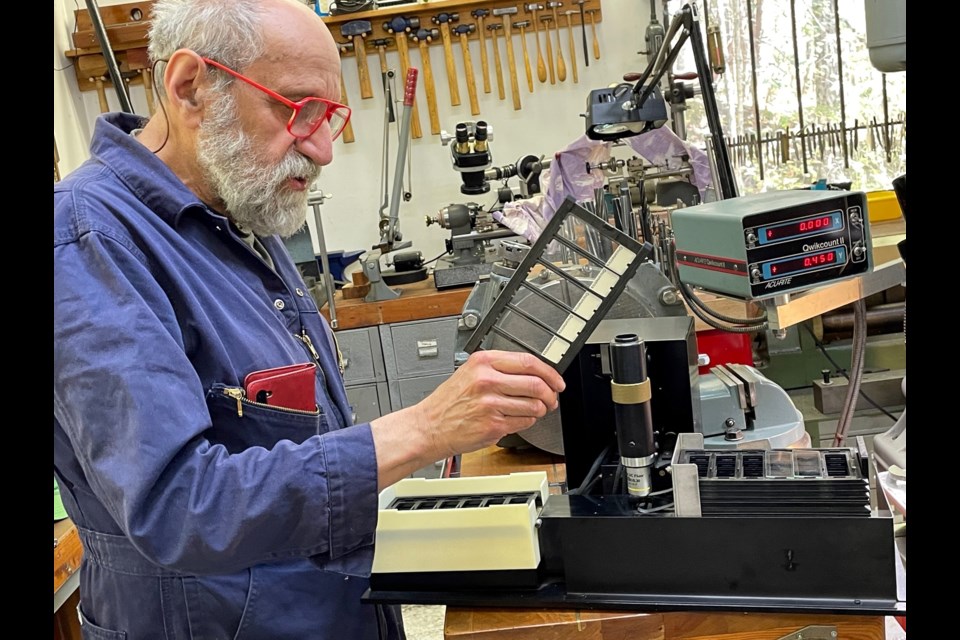On a dusty shelf of a workshop in Pender Harbour sits a device that is saving lives. It’s the prototype of the Motic Easy Scan Digital Slide Scanner that helps women and their doctors assess chances of cervical cancer.
The slide scanner is now used in many countries, particularly China, where it is helping an estimated 10 million Chinese women by scanning their pap smears (a test of cells taken from the cervix) to determine abnormalities that need medical follow-up, but it took three years to get it there.
The device was designed and built in Pender Harbour by a retired engineer and inventor, William Gelbart. He began working on his prototype in 2013, and was officially granted its patent in 2015. He and business partner Branko Palcic then worked for three years to sell the prototype’s design and patent to a medical equipment company, and they finally drew interest from the Chinese company, Motic, that is now manufacturing the diagnostic device and shipping it all over the world.
Gelbart shakes his head when he reads about the lengthy wait to took for women in B.C. to get results from their pap smears. In July, CTV News reported that a backlog of thousands of slides were sent out of province to the United States for analysis. On Sept. 25, the Provincial Health Services Authority told Coast Reporter the province transitioned to liquid-based cytology (sending collected samples as liquid in tubes to the lab rather than using slides) in 2023 and has restored the acceptable turnaround times for cervical cancer screening after reducing the backlog of pap smear samples.
Retired scientist Branko Palcic, PhD, (formerly of the BC Cancer Agency), confirmed in a recent interview that the system B.C. used was slower and more expensive than it needs to be. The Motic digital slide scanner, by comparison, could speed up the process as it takes an estimated two to three minutes to scan a slide. The technicians who scan manually are good, he notes, as it takes enormous skill, but they might take up to 15 minutes per slide and fatigue limits them to 60 to 65 slides per day.
“It never gets tired,” Palcic said, “that’s the big advantage.”
A study at the BC Cancer Agency showed that the automated slide scanner approach was better — faster and cheaper. Palcic estimates that the conventional cytology method used in B.C. labs cost $30 per slide.
“Our range [using the slide scanner] would be about $12 per slide.” In fact when Gelbart and Palcic first marketed the invention they hoped to provide the base equipment for free and finance it by charging each time a digital scan was accessed. Capital investment in medical equipment is onerous and this idea would have made it affordable. (Motic sells the scanners for about $25,000.)
“There’s no reason why every country on earth should not be able to afford the equipment,” Palcic said.
And their device’s use goes beyond cervical cancer. It can be used to determine oral cancer and prostate biopsy abnormalities as well.
The prototype of the digital scanner has a slide tray that passes beneath a camera that uses innovative optics to pick out abnormal cells and flag them for follow-up. Gelbart is an engineer by training with a background in medical imaging using radioisotopes for cancer treatment. Scanners did exist years ago, he said, but they were complicated and expensive. He wanted to automate them.
“It needed the computer software to develop the automation,” he said, “and the microscope slides were really the key.”
The system requires collection of the slides, staining and a magnification process. As the slide trays pass through the unit, the system automatically makes a fine adjustment to a focusing tube. The unit’s digital camera scans the findings into the computer for a doctor’s assessment.
Despite the success of the scanner, Gelbart and Palcic had a long road to sell the patent until a Chinese company recognized the power of the device and began to manufacture them. Now 200 to 300 systems are used all over the world. Over the last five years, 10 million Chinese women have been screened — many of whom have never been screened before, Palcic notes. Of that number, 200 women per 100,000 have presented with cells at a serious precancer level.
“That’s huge!” Palcic said.


